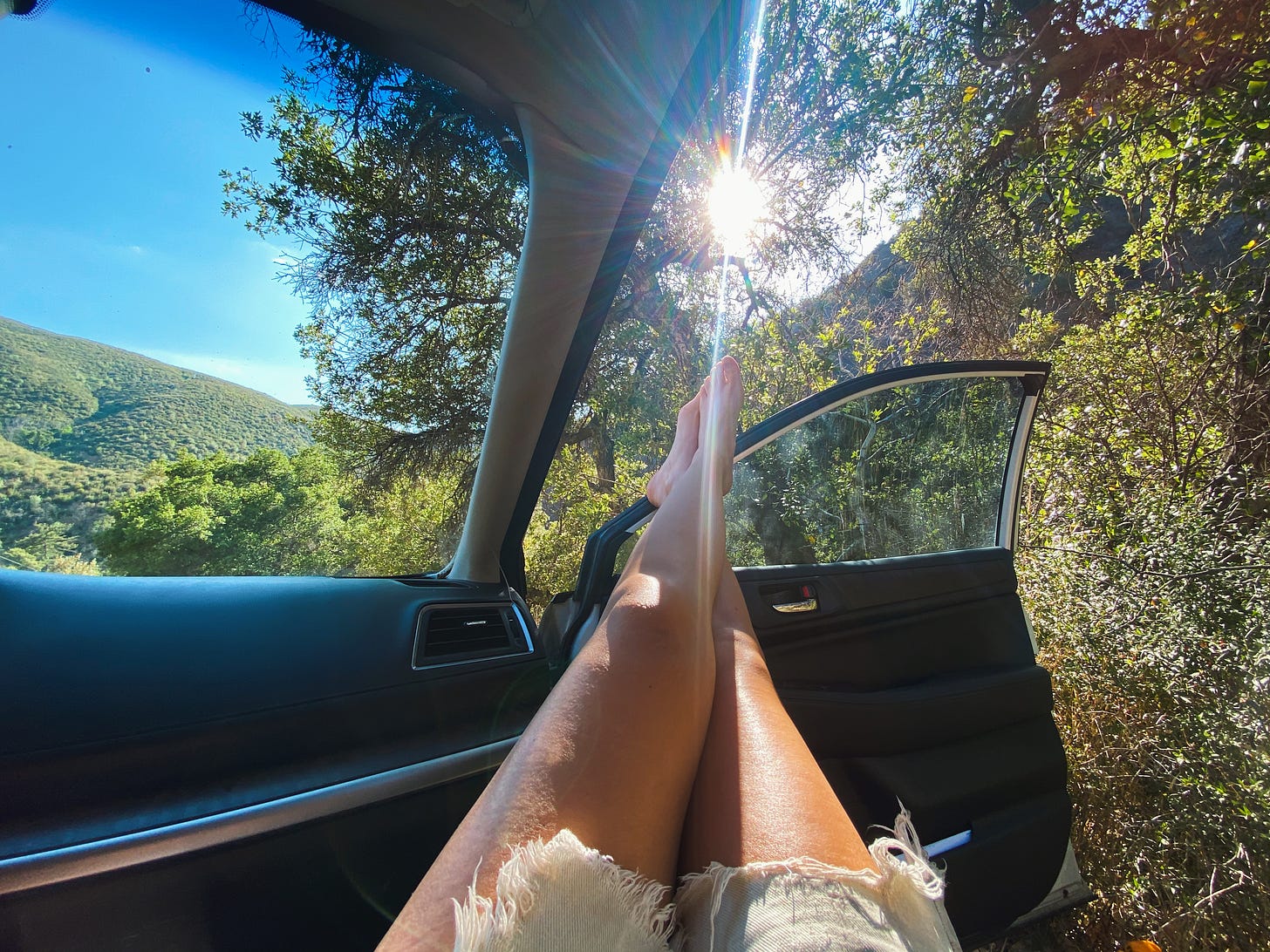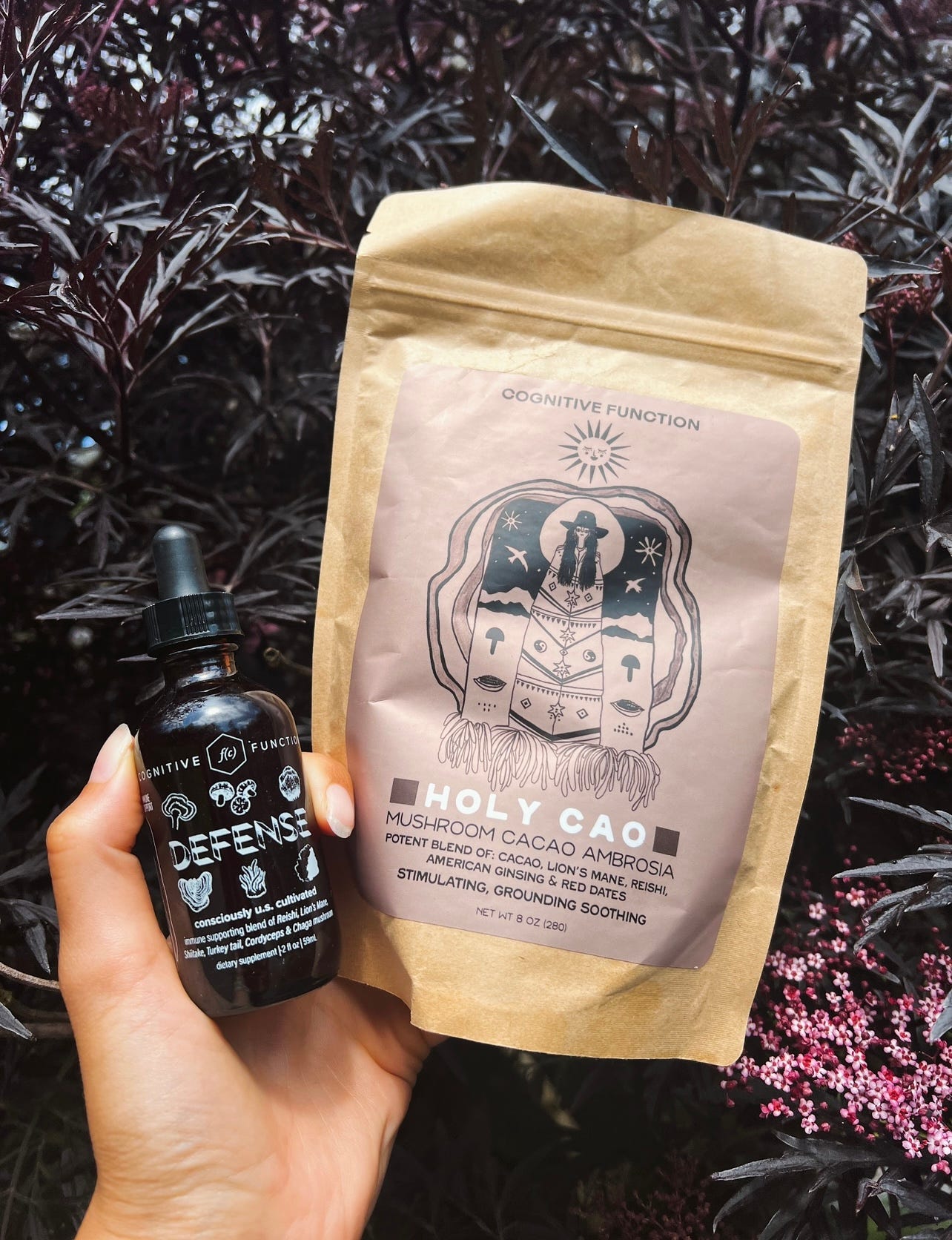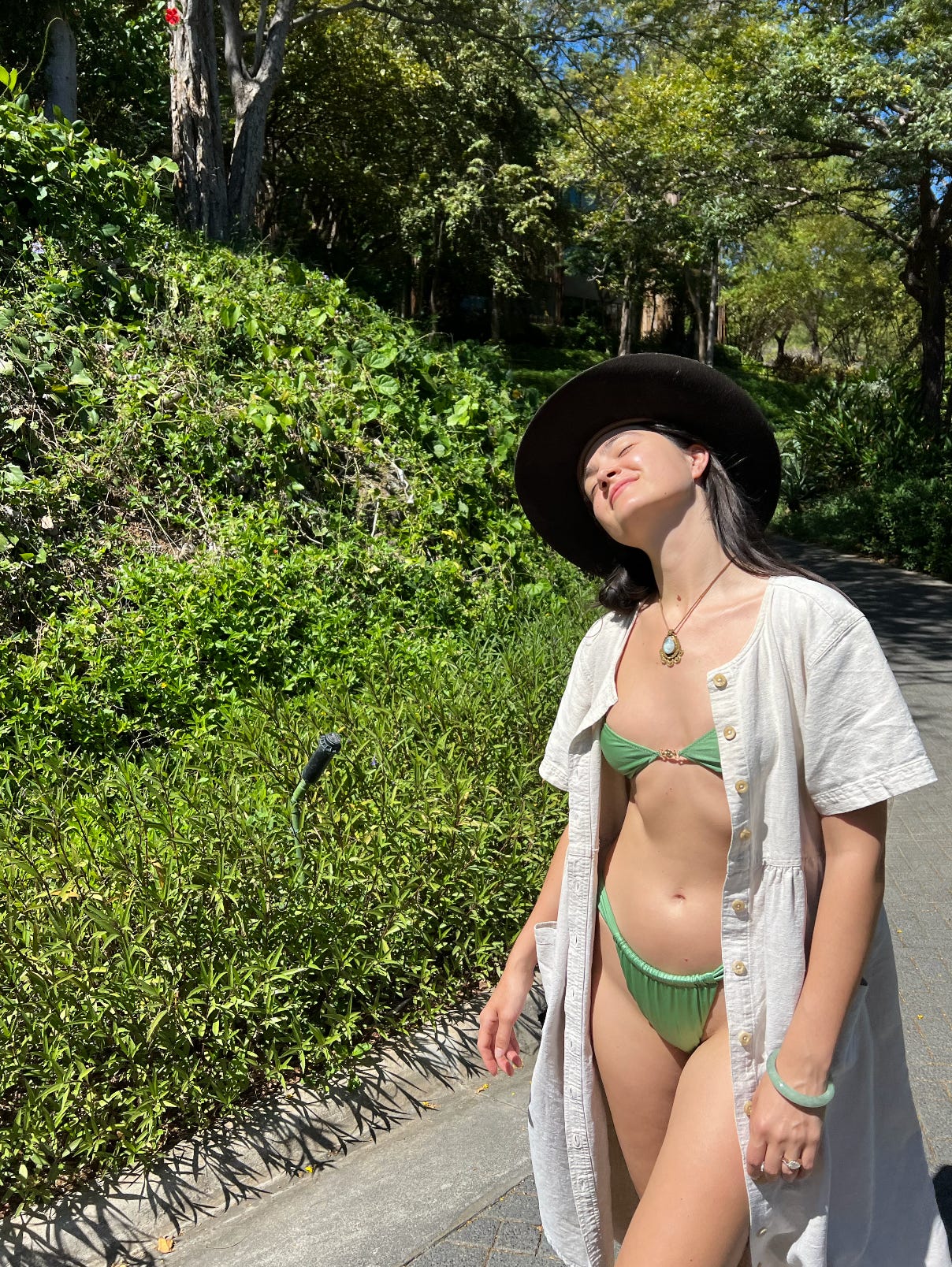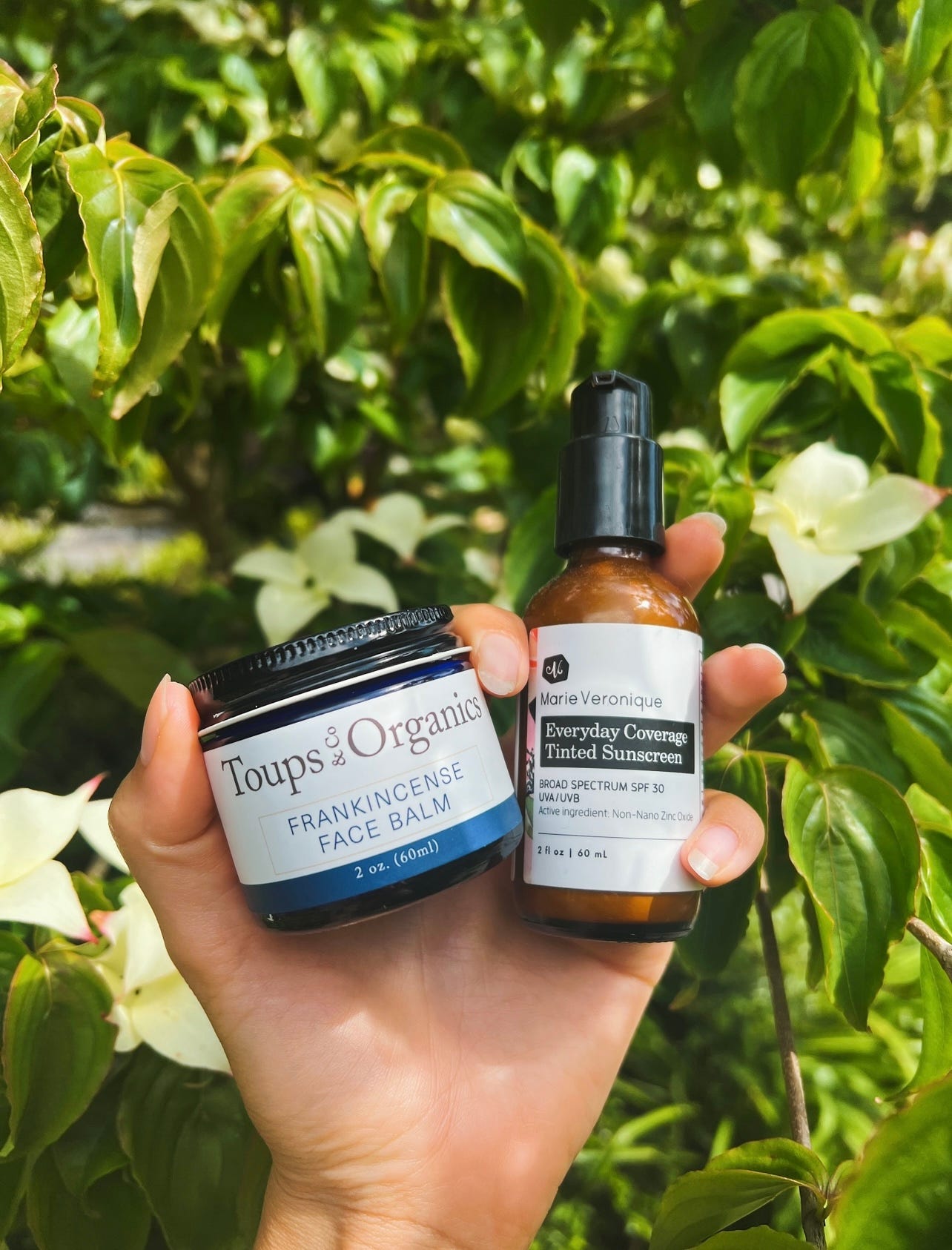Sunscreen: Friend or Foe? Part 2
We live in a society where everyone is willingly drugging their skin, do they know the answer to sun burn may exist in their diets...? Part 2 of 2. I also share my tips for being in the sun!
Opinions/ Experiences:
A couple of months ago, I was getting a facial at my favorite Korean bath house and the very American esthetician gave me a whole lecture on sunscreen. With my face and my mouth covered, I was unable to speak and just had to adhere to her rant.
A lesson I’ve been, oh so graciously, learning (more and more since COV*D) is that everyone has their own opinion and I can simply allow it to roll off my back like the way water rolls off a duck’s feathers if it doesn’t serve me.
We all have our own opinions, formed by our own experiences that have been influenced or molded by different programs, people, services, schools, cultures and lived experience. Your’s doesn’t have to be mine and mine doesn’t have to be yours.
Does that mean one is right and one is wrong? That is a question for the seeker. Take what applies and discard that which does not serve, respectfully.
Now, more on the Sun:
If you have read part 1 skip down to the next section as I attempt to very briefly sum up all that we covered. If you are only looking for my sun exposure recommendations, skip down to that section.
An interesting cultural narrative is that sunscreen is a lifesaver against deadly skin cancers. But in reality, it primarily only prevents sunburn, not malignant melanoma, which only accounts for 6% of skin cancer cases in the U.S. annually. This leaves a widespread misunderstanding exploited by various organizations, leading to a skewed perception of sun exposure risks. Surprisingly, some studies suggest sunscreen use might increase melanoma risk. Before the 1950’s when processed foods and western medicine came to the forefront, sunlight therapy (heliotherapy) was a key treatment for various diseases and in cancer research for its healing properties. The decline of heliotherapy coincided with the rise of the pharmaceutical industry, processed foods and the use of sunglasses, which block essential rays. Sunlight is crucial for vitamin D production, mood enhancement, immune support, skin health, cardiovascular health, and sleep regulation. Lack of sunlight can contribute to various illnesses, including cancer. Regular sun exposure provides numerous health benefits, and understanding its true role can help make informed health decisions.
A science lesson on: your body and the sun,
To understand how sunscreen works, we first have to understand the process our skin goes through when introduced to the sun.
When you are exposed to sun, you receive solar radiation which causes oxidation. The way your body combats this, is by bringing antioxidants up to those cells. Once you have used up all of your available antioxidants, your body burns. When your skin starts to turn red/ burn, this is your body’s way of saying that it has had enough and it cannot protect itself any longer. Even if it has been a short window of time. Isn’t it phenomenal the way our bodies communicate with us?
As you start to build up a tolerance to the sun, your body will produce a “tan” (more melanin). Tanning is the bodies natural process for protecting our skin.
Due to the fact that antioxidants play such a huge role in regenerating our damaged skin cells, our diets are imo, 70% of the puzzle here! Additionally, studies have shown that processed foods often high in Poly Unsaturated Fats (PUFAs) like Linoleic acid, can exacerbate skin damage when exposed to UV radiation. These unhealthy dietary components weaken the skin's natural defenses and impair its ability to repair DNA damage caused by sun exposure, thereby increasing the risk of skin cancer. This is super important to note and if there is one thing to take away from this article, my hope is that you understand the impact the PUFAs have on your body.
Introducing different types of Sunscreen/ ingredients to the body:
Skin cancer is a concerning element looming over deciphering how to protect ourselves from the sun’s rays. We have modern day options, but do the chemical “armors” have side effects?
On a personal note: commercial sunscreens scare the crap outta me. They come in aerosol cans or plastic bottles that bake in the sun which I feel super sketched out about. Is the plastic heating up and leaching into the solution or visa versa? Are the chemicals in the solution reacting to the chemicals within the plastic? I have no idea, but I have no intention of being the guinea pig that sticks around to find out.
Chemical filters (sunscreens) have 3 core chemicals that are used for protection. Their main role is to absorb the UV rays and off them in the form of heat. Due to their blocking nature they also alter the skin’s ability to breath which stops your skin from absorbing oxygen and expelling toxins. Studies show that all of these chemicals can be hormone distributing by way of mimicking estrogen in the body, interfering with testosterone production and disrupt adrenal hormones. Octinoxate in particular is readily absorbed by the body and has even been detected in human breastmilk and urine, not to mention it becomes carcinogenic when exposed to sunlight….yikes. Your skin absorbs whatever you put on it, meaning these are going straight into your system whether you like it or not. I think something that makes me nervous is the way we are baking them into our skin while we are heating up in the sun…scary.
Chemical filters
These ingredients absorb UV rays:
Oxybenzone: A common filter that absorbs UVB rays, which cause sunburn and increase the risk of skin cancer, and some UVA rays, which cause skin aging.
Avobenzone: Effective against UVA rays, but can degrade when exposed to sunlight. It's often combined with other filters to make it more effective.
Octocrylene: An organic UV filter that absorbs UVB radiation and short UVA wavelengths. It's a common ingredient in chemical sunscreens and anti-aging creams.
Octinoxate: A common chemical sunscreen ingredient that absorbs UVB rays, but it can disrupt hormones and has been found to become carcinogenic when exposed to sunlight.
Physical or Mineral ingredients reflect or scatter the UV rays. These act similar to a “screen”. Physical/ Mineral sunscreens are made with titanium dioxide and zinc oxide, usually in the form of nanoparticles. In 2021 the FDA proposed that both titanium dioxide and zinc oxide can be classified as GRASE (Generally Recognized As Safe and Effective.). They are the only GRASE compounds found in sunscreens. Evidence suggests that few, if any, zinc or titanium particles penetrate the skin to reach living tissues. I tend to lean toward Zinc oxide apart from anything else. Find more information here from the EWG.
Physical/ Mineral ingredients
Titanium dioxide: Used in mineral-based sunscreens, it can help prevent sunburn and sun damage. It's often combined with other sunscreen agents to provide broad-spectrum protection.
Zinc oxide: Mineral sunscreen ingredient that provides broad-spectrum UV protection by sitting on top of the skin and reflecting harmful rays without penetrating the skin.
FDA & sunscreen ingredients: Resent studies have shown evidence of sunscreen chemicals present in the plasma of participants (Source), the FDA is proposing that until more studies are conducted, the ONLY two ingredients that should be listed as GRASE are Titanium Dioxide and Zinc Oxide. Zinc Oxide and Titanium Dioxide sit on top of the skin and do not get absorbed due to their large molecule size, making them safe for continued use.
So how do we protect our skin?
Cass approved tips and suggestions:
1.) Remove seed oils (PUFAs) from your diet.
Linoleic acid is a polyunsaturated, omega-6 fatty acid that has commandeered our American diet from about the 1950’s to learn more about that find my article here. Seed oils include canola, sunflower, grapeseed, cottonseed, safflower, soybean and corn oils. They are the base for almost everything from in restaurants, bagged foods, and most all processed foods on the market, they also happen to be the base of many sunscreens. These oils cause cellular damage and cause your tissues to oxidate rapidly making prolonged sun exposure extremely dangerous. LA has the ability to penetrate the skin and change the distribution of other fatty acids. Some research suggests that the amount of polyunsaturated fatty acids (PUFAs) in a person's diet can control how susceptible they are to UV radiation damage, including sunburn and skin cancer. Eliminating seed oils from the diet may reduce the risk of sunburn and dare I say it, skin cancer (not a doctor yet don’t come for me).
I believe this is the reason why skin cancer is at an all time high. Not the sun, our diet, specially Linoleic acid and it’s effect on our body. LA is making our bodies susceptible to issues we (as a population) have never seen before.
2.) Up your vitamin E intake if ingesting seed oils regularly.
Vitamin E will protect your body from PUFA’s. Vitamin E increases the conversion of linoleic acid into saturated fat. It protects your skin from UV light which increases lipid per-oxidation when it reacts with PUFAs. I rarely recommend supplements, it’s not my game, I focus on food first. Foods high in Vit E are, Animal liver, Eggs, Red bell pepper, Tomatoes, Mangos, Kiwis, Apricots, Olive Oil. My goal is to eat bio-regionally, seasonal, nose-to-tail (meaning whole animal gets used, nothing wasted), grow as much as we can or support our local farmers and if I have to go to the grocery store, I read every label. Supplements for vit E is MitoLife they are one of few that is clean Vitamin E with mixed tocopherols derived from sunflower oil, not soy.
3.) Get more antioxidants in your body!
We can fight cell oxidation and our bodies do it naturally by using antioxidants. When your skin starts to burn it is due in part because you have run out of the antidote of antioxidants. Antioxidant foods look like Mushrooms (chaga is my all time fav see 3.5), avocados, berries, cocoa, cruciferous vegetables, green tea, nuts. Antioxidant are able to prevent the absorption of UV light into the skin. Unlike sunscreen, this protection can last days, rather than hours.
3.5.) My go-to’s Cognitive Function sunscreen: DEFENSE & Holy CAO!!
They are both so so so rich in antioxidants and are simple to get in everyday and travel really well. DEFENSE is LOADED with Chaga mushroom which is one of the highest forms of antioxidants in the world!! We dual extract it for 30 days and it all comes from here in the U.S. It is perfection in a bottle. The application can work into almost any lifestyle and it travels with me everywhere I go (see my article on travel hacks here). The HOLY CAO is chocolate from a small farm in Ecuador, it is also a nice spicy mid-day pick me up. If you want to start using antioxidants as skin protection you need to start 2 weeks before your first major skin exposure.
4.) Cover up.
Seems obvious but so many people want to skip to the part where they get super tan, fast so they don’t do this and it backfires. I love a big floppy hat, bucket hat or whatever I can steal from Colt to throw on my head to protect my face and neck! Long silk, linen or cotton shirts are my go-to for protecting my arms and a sarong or skirt for my legs is usually the move.
5.) Exposure time/ timing.
Like the seasons here in the PNW, nature has the answers. Start heading outside in the spring when the sun is more mild and work on your exposure. As the months build you should have a nice base by the hotter summer months start to roll around. Almost 100% of UV rays are converted into heat and easily dissipate by the of the melanin in your skin. This prevents sun damage at a cellular level. If on vacation, take it slowwww. On your first day start with 15mins and work your way up.
The best times for sun exposure are during the early morning and late afternoon. These periods typically fall between 8:00 AM to 10:00 AM and 4:00 PM to 6:00 PM, depending on your location and the season. During these times, the sun's rays are less intense, reducing the risk of sunburn and skin damage while still allowing your body to produce adequate vitamin D. Avoiding the peak midday hours, usually from 10:00 AM to 4:00 PM, helps minimize exposure to the strongest UV rays.
6.) Astaxanthin
Astaxantin a powerful antioxidant found in microalgae, salmon, shrimp, and other seafood, is gaining recognition for its potential as a natural sunscreen. I don’t use it and never have. I don’t love supplements due to reasons I shared in section 2. However many find success with this. Astaxantin is a carotenoid with potent antioxidant capabilities, neutralizing free radicals generated by UV exposure that can damage skin cells and lead to aging and skin cancer.
7.) Skip the Sunglasses
As much as I love a good sunglass moment (I love going incognito), these shades block your retnas from receiving and perceiving the sun and it’s strength. When wearing sunglasses, we block the sun's critical messages and our body can't effectively tell time. This can result in disrupted circadian signaling, which manifests as mitochondrial inefficiency, hormonal imbalance, metabolic disorders and cognitive dysfunction.
8.) Cass approved Sunscreens
I love Toups & Co Organics. The base is tallow and feels great on my skin when I do use sunscreen which is very rare (usually when we are traveling south).
For a mineral based tinted SPF, I have recently been trying out Marie Veronique. I like it but it is very mineral-ly and dare I say, a bit gritty…? But I do love the way it goes on the skin and the minimal coverage is nice for days by the pool.
9.) After care
I highly recommend applying a quality moisturizer to your after sun care routine. For an inexpensive option I like the unscented Alaffia Lotion, it has pretty clean ingredients and the shea butter is great. For a more luxurious option, as always I am a big GARA girlie and love the Zen Cream and the Everyday Oil. If you are into oiling up your bod, you can always make your own or use a combo some favorites I have are raw shea butter and sesame seed oil.
The sun blesses us with an abundance of benefits: it helps our bodies produce essential vitamin D, bolsters our immune systems, uplifts our mood, enhances cardiovascular health, alleviates depression, and promotes relaxation. This summer, I urge you to forge a deeper connection with the sun. Pay attention to how your body responds—how long before your skin starts to turn red? Which areas are more resilient? Notice how consistent sun exposure influences your well-being. Dare to experience the sun naturally, without the interference of chemicals, and discover the profound effects it can have. Embrace the sunshine and let it work its wonders on you.
Be mindful and go slow. The sun isn’t something to be afraid of, chemical sunscreens and man made vegetable oils distributing our human flow are, we should all rage lol.
Sending love, sending sunlight,
Cass







